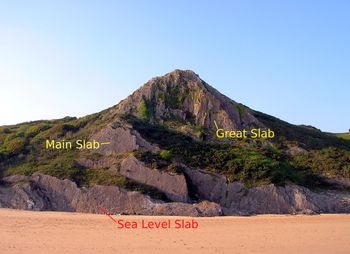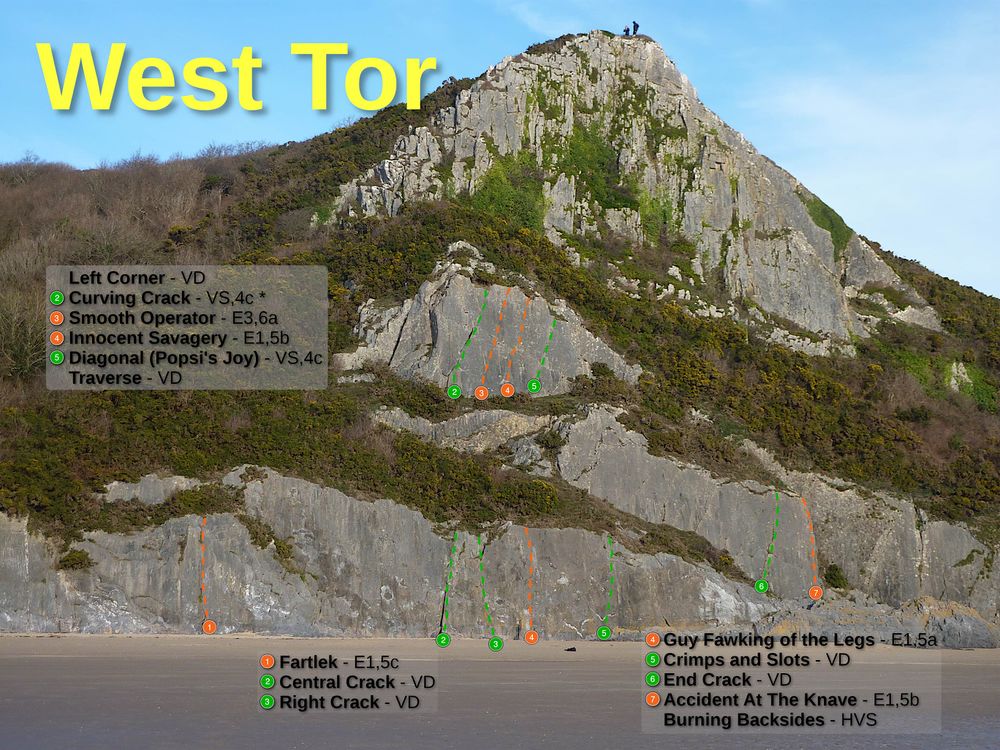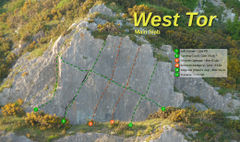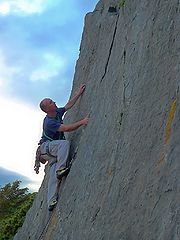West Tor
| West Tor | |
 | |
| Rock Type | Natural Carboniferous Limestone |
|---|---|
| Climbing Style | Trad |
| Approach Time | 20 minutes |
| Area | Gower |
| Sub Area | Tor Bay and Great Tor |
| Geodata | |
| WGS-84 Location | 51.570017, -4.129828 |
| OS Grid Ref. | SS 524 878 |
| WGS-84 Parking Location | 51.575583, -4.127859 |
| GR Parking Location | SS 526 884 |
| Parking Postcode | SA3 2HJ |
| Base Elevation | 0 metres (Other) |
| General Info | |
| Faces Direction | South |
| Aspect | Sunny |
| Wind Sheltered | Seldomly |
| Climbing Type | Normal |
| Seepage | Never |
| Tidal | |
| Before/After Low Tide | 4.0 hours (See Note) |
| Crags Within 400m | |
Contents
Tidal Status
The routes from on the Sea-Level Slab are accessible 4-5 hours either side of low water. The rest of the crag is non-tidal.
ACCESS
From the parking at Penmaen, pass through the gate and follow the rough track. After 200 metres pass an old barn on your right. Here the track makes a sharp right and then a sharp left turn and becomes a narrow concrete path between high hedges. After 300 metres you come to a gate.
Go through the gate and then, after 25 metres take a right turn and follow this path for 200 metres.
From this point follow the path down to Tor Bay (signposted) fairly steeply down for 430 metres until you arrive at the beach.
Walk south-west (right) for 280 metres. Little Tor and Little Star Wall will be on your right.
From Little Tor, walk 100 metres westwards along the beach to reach a slanting gully/ramp. The Sea Level Slab is a few metres further along the beach. For Main Slab Go up the gully and work your way upwards between gorse bushes and then scramble steeply to the ledge below West Tor Main Slab
Descents
Descents from Fartlek to End Crack and Main Slab are down obvious paths. Descent from the Great Slab is by walking off right (east) at the top and descending the vague path to the east of the slab. Lying 100m west of Little Tor, West Tor is comprised of three tiers of cliffs. The lowest is the Sea Level Slab. Directly above this lies the Main Slab, whilst up and right again, is the inappropriately named Great Slab. The Main Slab is best accessed from the beach (unless the tide is in), the Great Slab is best reached from the top by walking down its east flank as described in the access notes.
Preamble
Lying 100m west of Little Tor. The Family rating for this crag is for the beach section only.
Sea Level Slab
Lies down at beach level, slightly west of the main slab. It is marginally tidal on spring tides.
- Fartlek - E1,5c
The diminutive route lies on a subsidiary buttress 10m left of Central Crack. It takes a thin crack up the centre. 7m. - Central Crack - VD
The obvious wide crack is quite stern for the grade. 7m. - Right Crack - VD
Some 2 metres right of Central Crack are some drill holes at eye level, with a crack above. Climb up on the left side of this. 7m. - Guy Fawking of the Legs - E1,5a
Climbs the left side of the compact central section of slab, right of Right Crack. Direct at first, then trending leftwards at about 2/3rds height. Un-protected. 8m. - Crimps and Slots - VD
To the right is a descent route, then an inset slab, at the right end of which is an arête. - End Crack - VD
The obvious right-slanting crack at the right end of the slab. 8m. - Accident At The Knave - E1,5b
Take the left side of the prominent arête diagonally down and right of the main slab and finish on its edge. 9m. - Burning Backsides - HVS
Start at rocks on the right side of the main sea level slab. Move up and leftwards to a vague traverse line about 5m up and cross the arête and corner dropping a meter or so. Proceed leftwards across the rest of the slab.
Main Slab
Directly above the beach level slab is this compact face.
- Left Corner - VD
An indefinite route. Climb the left edge of the slab until it steepens. Move left into and up a short corner to the top. 11m. - Curving Crack - VS,4c *
Obvious from its name, this splendid climb is straightforward with a little thought. 11m.[1] - Smooth Operator - E3,6a
A thin eliminate between Curving Crack and Innocent Savagery. 11m. - Innocent Savagery - E1,5b
A tricky direct start attains the bunch of cracks right of Curving Crack. 11m. - Diagonal (Popsi's Joy) - VS,4c
Climb the thin crack on the right side of the slab. 11m. - Traverse - VD
Follows the footledge left across the slab. 12m.
Great Slab
Up and right through a great deal of scrub lies the Great Slab. The front face is vegetated. No one climbs these routes.
- Uno - M
On the left (west) side of the slab is a short wall containing thin cracks, with a short chimney to the right. Gain the short chimney, then move left to a ledge. Finish up the ridge above. A poor route. 18m. - Due - VD
Overgrown. Right of Uno is a wall with two cracks leading to an obvious rib. Follow these to finish direct. 21m. - Tre - HS
The start is overgrown. Start 2m right of Due, below an overhanging flake. Move right round this to a ledge and follow an edge to the top of the rib on Due. Traverse right to a corner crack with a small overhang to finish. 21m. - Nemesis - S
The start is overgrown. 12m right of Tre is a steep wall lined with cracks leading to a square ledge. A rib above leads to another ledge. Climb the wall above, which is bounded on the right by a smooth yellow pillar. Trend left to finish. 21m. - Right Rib - D
Climb the right edge of the main face of the Great Slab, loose in its upper section.
The remaining routes lie to the right (east) of the main face, centred about a slab containing an inverted y-crack. 27m. - West Diedre - S
A poor route up the corner left of Notched Rib. Scrambling leads to the top. 9m. - Notched Rib - S *
A hidden gem. Takes the rib on the left of the slab. 7m. - Electrico - E3,6b
A desperately technical little number taking the thin cracks in the centre of the slab. At this grade it is necessary to place wires in the thin crack from the corner on the left before starting, otherwise the route is much more serious (E5), with no gear until after the first crux. 11m. - Right Edge (Cooking The Books) - E1,5a
The right arête of the slab, starting either direct up the arête, or from the pedestal of Central Route, via the solution pocket. Originally utilised peg protection. 11m.
First Ascents
Sea Level Slab
- Fartlek - P.Lewis, A.Sharp 1985
- Central Crack - Unknown Pre-1973
- Right Crack - Unknown Pre-1973
- Guy Fawking of the Legs - Nick Taylor, solo 26.5.09
- Crimps and Slots -
- Accident At The Knave - M.Crocker 13.03.1999
- End Crack - Unknown Pre-1973
- Burning Backsides - Probably done before - C Wyatt, Charles Mason - May 2009
Main Slab
- Left Corner - J.Talbot, G.Jones 1959
- Curving Crack - J.Talbot, D.Corbett 1958
- Smooth Operator - A.Sharp, P.Lewis 1985
- Innocent Savagery - J.Kerry - Central Route 1971
P.Lewis, A.Sharp 1985 - Diagonal (Popsi's Joy) - J.Kerry 1971
- Traverse - J.Talbot, G.Jones 1959
Great Slab
- Uno - J.Talbot 1970
- Due - J.Talbot 1970
- Tre - J.Talbot 1970
- Nemesis - J.Talbot 1970
- Right Rib - R.Bradley 1998
- West Diedre - J.Talbot, G.Jones 1959
- Notched Rib - J.Talbot, D.homas 1959
- Electrico 11m - J.Talbot, G.Jones - Direct A1 1959
FFA A.Sharp, P.Lewis 1985 - Right Edge (Cooking The Books) - J.Talbot, G.Jones 1959
Additional Photos
Notes
- ↑ Described long before the widespread adoption of sticky rubber by J. O. Talbot in Gower Peninsula (1970), p.73, "A deep cut in the slab. A very difficult climb, involving acrobatic, out of balance moves; divided into two sections, the lowest being the hardest. 35ft., VI."



